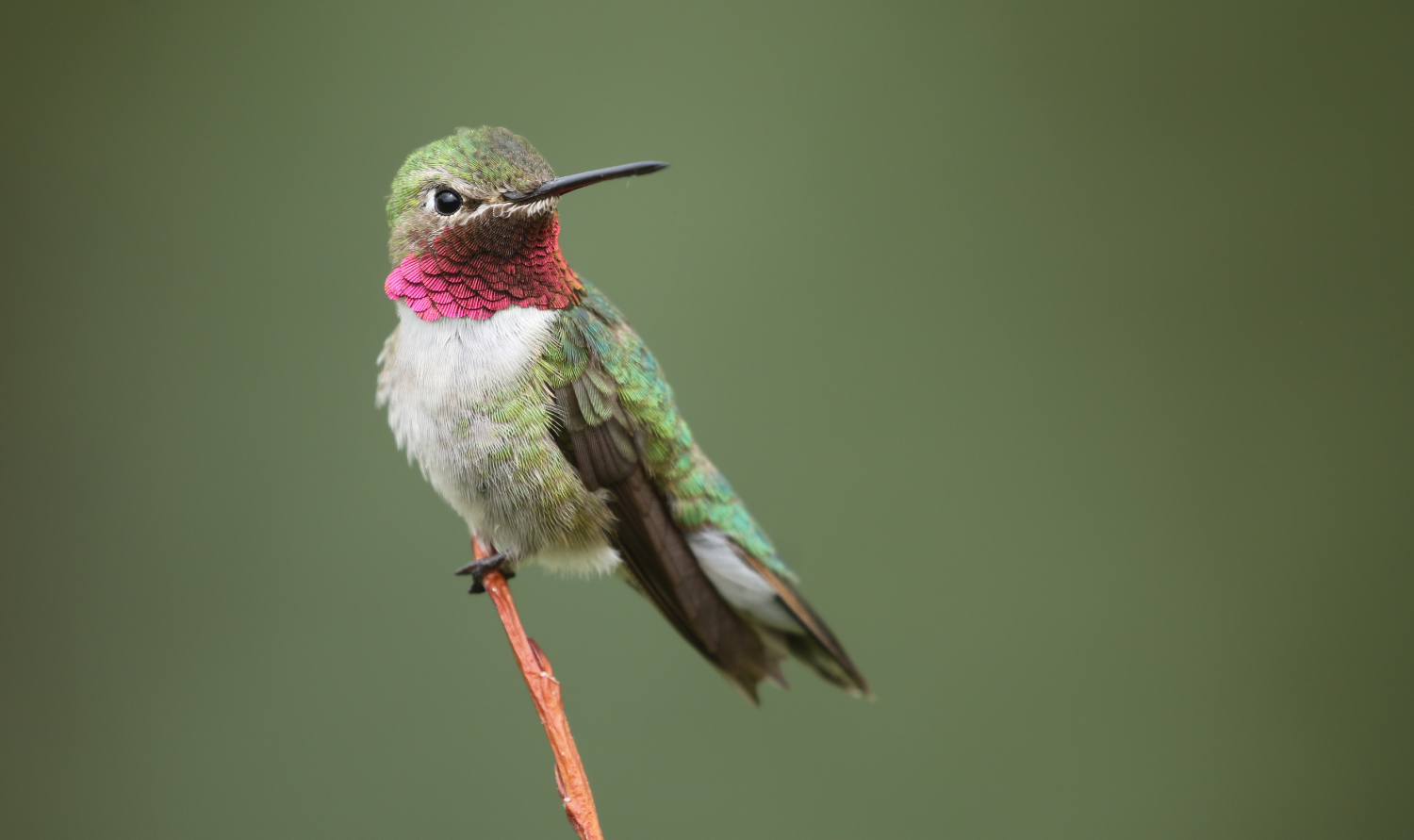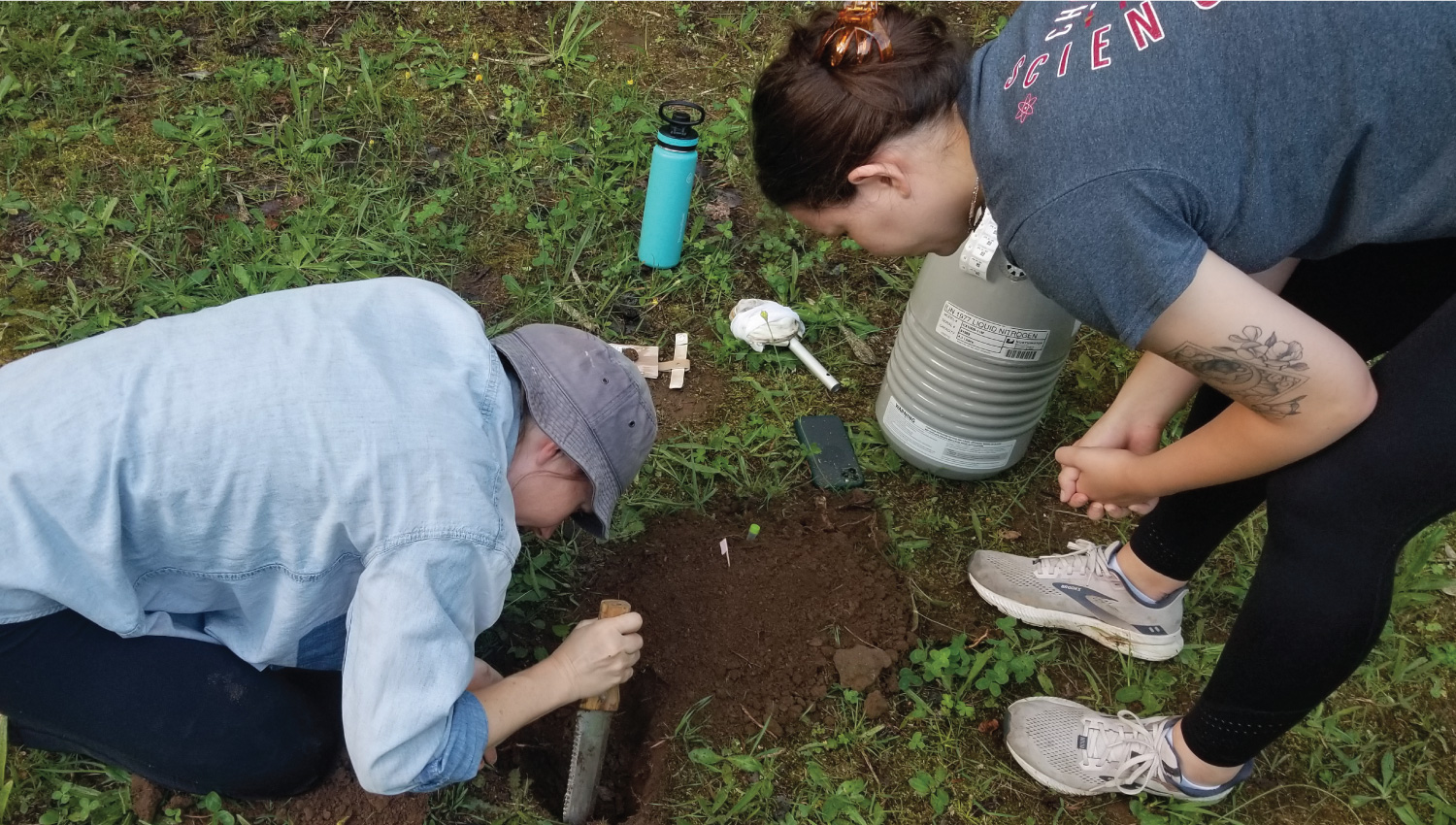The birds and the bees: For their senior thesis work, Darcy Chang and Joanna Shoubaki explored the sensory ecology of hummingbirds and sweat bees
Princeton senior Darcy Chang spent the summer of 2022 photographing hummingbirds and wildflowers at the Rocky Mountain Biological Laboratory in Colorado to explore how climate change might be impacting the tight-knit relationship between Broad-tailed hummingbirds and the flowers they pollinate.
That same summer, Joanna Shoubaki spent six weeks digging up bee nests in Japan to explore how an unusual species of sweat bee (Lasioglossum baleicum) uses odor to communicate. “They nest underground, so it’s dark and they can’t see anything,” said Shoubaki. “Aside from physical interactions, there’s basically no other way for them to communicate besides olfactory cues.”
Both students studied different aspects of sensory ecology — how organisms use their senses to extract information from their environment, make decisions, and interact with other individuals of the same or different species.
Chang and Shoubaki conducted their field research projects, in Colorado and Japan respectively, with support from the Becky Colvin Memorial Award, which is presented each spring by the High Meadows Environmental Institute (HMEI) and the Department of Ecology and Evolutionary Biology (EEB) following a competitive application process. The award provides support for travel, research supplies, and other expenses associated with field research connected to their senior thesis. Juniors in the Certificate Program in Environmental Studies and concentrating in ecology and evolutionary biology are eligible to apply.
A “pollinator’s eye-view” of wildflower color
“I’ve always really liked the natural world, so it was a natural choice for me to major in EEB,” said Chang. “Then I took professor Stoddard’s class on sensory ecology and that really opened up my eyes to this whole new field.”
“It’s fascinating to think that there are all these different ways of seeing the world, and it’s really hard to understand how another animal perceives their environment and how that affects their behavior,” said Chang. “I’m particularly interested in the ways that different sensory systems influence species interactions, which is what we were looking at in Colorado.”
When two species interact very closely, they often synchronize different parts of their life cycle. This is the case for the Broad-tailed hummingbird (Selasphorus platycercus), the focus of Chang’s thesis work, and the plants it pollinates.
Broad-tailed hummingbirds are tiny (though considered “medium sized” for hummingbirds) with green backs and white bellies. Males sport magenta-colored throats, and their wings make a distinctive trilling noise when they fly. Every year, the hummingbirds spend their winters in Mexico before returning to the American West in May to prepare for their summer breeding season.


Historically, by returning in May, the hummingbirds arrived in time for peak flowering, meaning there was sufficient energy to fuel breeding and, from the flowers’ perspective, sufficient birds to pollinate. But scientists think that climate change might disrupt the environmental cues that tell plants when to flower and hummingbirds when to migrate. There’s already some evidence that wildflowers are beginning to bloom earlier in the year. These disruptions could have ecosystem-wide implications.
“When environmental cues start to shift because of different climate related factors, there’s a possibility that it might disrupt interactions between species, which could ripple out to have larger community-wide impacts.”
Chang joined Mary (Cassie) Stoddard’s lab as an intern in 2021, the summer after her sophomore year. That summer, she traveled to the Rocky Mountain Biological Laboratory (RMBL) and worked alongside other interns to build a database of the flowers present around the field site. This isn’t any ordinary database: by taking UV photographs and spectrophotometer readings of flower petals, the group is building a picture of how pollinators like hummingbirds and bees might perceive the RMBL wildflower community.
“It’s so surprising to take a picture of a flower that you’re perceiving as just being purple, and then it comes out with this interesting UV pattern,” said Chang.
In summer 2022, Chang again travelled to RMBL to collect data for her senior thesis. Her goal was to describe hummingbird foraging behavior — how it changes throughout the summer, what flowers they rely on, and how foraging differs for male versus female hummingbirds — and to further characterize the plant community. Her project adds another piece to the picture that the Stoddard lab is building of hummingbird-flower interactions and the role of the hummingbird’s visual system in choosing which flowers to visit.
Chang made several unique and impressive contributions to the lab, said Stoddard, who is an associate professor of ecology and evolutionary biology. “Darcy devised a new way to conduct wildflower transect studies, initiated a project on a “pollinator’s eye-view” of wildflower color, and made new discoveries about the ways in which male and female hummingbird differ in wildflower use.”
At the field station, Chang and the other lab members set up cameras in front of different flower species to monitor hummingbird visits — an endeavor that the lab has undertaken every summer since 2018. Chang also continued to characterize the floral community at RMBL by collecting data on the abundance of different wildflower species.
“In the mornings, we would move our cameras to different flowers, and in the afternoons, we would walk along our transects and count the number of flowers that were blooming,” said Chang. “It was my first real field work experience, and I really liked being able to spend time out in in the mountains and having the opportunity to work by just sort of walking around and looking at flowers.”
The project also taught her a lot about the need to be flexible in the field. “For the floral reflectance information, we were trying to take the photographs in consistent lighting because that’s probably ideal for understanding the color, but we were struggling a lot because towards the end of the summer, thunderstorms would roll in basically every afternoon, so we had to adapt to that by switching around the timing or the way that we would do certain projects in order to accommodate these clouds and thunderstorms.”
Overall, the hummingbirds visited flowers of many different colors, though they seemed to like red flowers best. Chang also identified two species that the hummingbirds seemed to feed on preferentially and showed that that male hummingbirds were more flexible about which flowers they visited. Her work also revealed that the hummingbirds are visiting some species that are generally thought to be bee-pollinated.
“I found a couple of species of flowers that we think that the hummingbirds visit that had interesting UV patterns that are thought to be landing pads for bees, which suggests that there’s some generalization in the pollinator network,” said Chang.
Chang learnt a lot from the project, and she’s excited to pursue more research. In the fall, she will begin a PhD program in ecology, evolution, and marine biology at UC Santa Barbara, where she will study the sensory ecology underlying a different mutualistic relationship: between cleaner shrimp and the fish they service.
“It has been a privilege to watch Darcy grow from a research intern to a true leader at our field site,” said Stoddard. “I can’t wait to see what great science she will do next.”
What do bees smell like? Using scent to communicate underground.
“The first goal was to just find out what do these bees even smell like,” Shoubaki said.
As a junior, Shoubaki knew she wanted to work with Sarah Kocher for her senior thesis research, but she didn’t quite know what to study. “We clicked when we met, and I thought she would be really wonderful to work with,” said Shoubaki. “But when it came time to choose a project, I didn’t know what to do, so Sarah handed me a bunch of papers by different people in the lab and said ‘why don’t you just start sniffing around and see what might pique your interest.’
After much sniffing about, Shoubaki found the rabbit hole she wanted to dive down. “Eventually I stumbled upon some papers that talked about the olfactory systems of sweat bees, and how things like dominance and nestmate recognition are basically run by these systems, and I decided that that’s the kind of project I wanted to explore.”
“Joanna saw a unique way to combine our lab’s expertise in bee biology with questions she has about the evolution of social behavior,” said Kocher, Shoubaki’s thesis advisor and associate professor of ecology and evolutionary biology and the Lewis-Sigler Institute for Integrative Genomics.
Lasioglossum baleicum bees are unusual in that female bees choose between two very different lifestyles – they either live solitary lives and raise their broods on their own, or they choose to become queens and employ their first-born offspring as worker bees to help raise later litters. Shoubaki wanted to explore how queens use pheromones to communicate with — and maintain dominance over — their workers.
“Unlike other bee species, L. baleicum workers aren’t as non-reproductive as they claim to be,” said Shoubaki. “There’s a subset of workers that have developed ovaries and who end up either sneaking their own eggs into the nest or running off to make their own nest.”
To prevent these types of mutinies or desertions, queen bees need to communicate with their workers to keep them in line. In other species of sweat bee, queens produce odorous chemicals such as macrocyclic lactones to repress ovarian development in their workers, but very little is known about olfactory communication in this species.
Shoubaki’s first goal was to find out what L. baleicum bees smell like, and whether queen bees smell different from worker bees. To do this, she extracted odorants and pheromones from several frozen bees that had been collected previously and made chemical mixtures resembling the queen’s odor profile. “Illuminating the difference between workers and their queens allows us to point to specific chemicals and say, ‘since queens are making more of this chemical than workers, it might be maintaining dominance and suppressing the reproduction of workers’,” Shoubaki explained.
Then, to test whether this queen-mimicking chemical mixture would impact the behavior of worker bees, she and several other lab members headed to their field site near Sapporo, Japan to collect some bees.
“A day in the life is waking up at 4 a.m., and after breakfast you hike for about a mile out to the field, and then from there you pick out the nest you want to dig and you sit down with a big old digging knife and dig for 6 hours,” said Shoubaki.


After excavating a nest, Shoubaki would transport it and all its bees back to the makeshift lab in her AirBnB to test whether the aroma of a queen bee would alter their behavior.
Back at the “lab”, Shoukabi placed individual worker bees in an arena with a “dummy queen” — a glass bead that was coated with the scent signature of a queen bee — and recorded their behavior. Specifically, she wanted to see whether the queen’s odor would induce subordinate responses in the worker bees.
“The subordinate behaviors we were interested in are withdrawals and c-postures,” said Shoubaki. “Withdrawal is when she touches the bead with her antenna and then lurches back quickly and tucks her abdomen underneath her, and a c-posture is basically a withdrawal turned up to the nth degree: at that point, she’ll lurch back and draw her abdomen completely under so her body makes a c-shape; we think it’s really a defensive behavior.”
Shoubaki found some evidence that queen bees do smell different from solitary females, though their overall pheromone profiles were similar. “When we broke it down to look at the compounds individually, we did find differentiation: there were a few compounds that were either biased towards queens or biased towards solitary reproducers.”
The behavioral tests suggested that, like in other species, macrocyclic lactones might induce subordinate behavior in worker bees, but Shoubaki plans to run these tests again this summer with an updated and “cleaner” queen-mimicking scent, and a larger sample size.
As a researcher, Shoubaki stood out for her determination and eagerness, said Kocher. “She did not waste a minute of her time – she arrived with a clear plan of what she wanted to collect and how she planned to collect it. Some of the work was grueling — waking up at 4 a.m. to dig up nests in the rain is not something I have seen typical undergraduate students get excited about — but Joanna kept this up for almost two months without a second of hesitation,” said Kocher.
Shoubaki’s senior thesis experience taught her a lot about the realities and joys of field research. “I think the biggest lesson I learned was that research is more of an art than a science, which sounds counterintuitive, but out in the field you have to make all these decisions or creative solutions to problems that you didn’t think you’d come across in the field,” said Shoubaki.
After she graduates this May, Shoubaki will join the Kocher lab as a field assistant to continue working on the project, and she’s excited to return to Japan for another field season this summer. “Even though the field work was so physically difficult, it was still very fun, and I’m excited to go back and do it again,” said Shoubaki.




